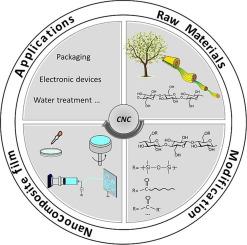Carbohydrate Polymers ( IF 10.7 ) Pub Date : 2022-06-27 , DOI: 10.1016/j.carbpol.2022.119790 Chaimaa Gomri 1 , Marc Cretin 1 , Mona Semsarilar 1

|
Cellulose nanocrystal (CNC) has recently gained much attention due to its unique properties such as abundancy, biodegradability, high strength, large surface area, functional ability, template structure, and sustainability. To broaden its application and enhance its compatibility with other materials, CNC can be modified via different methods. The modification is based on introducing new functions, including esterification, silylation, carbamation, polymerization, and so on. The application can concern many fields, such as polymer reinforcement, packaging, water treatment, textiles, biosensors, etc. Herein, we summarize the main approaches employed for the chemical modification and the use of the modified CNC material in the preparation of nanocomposite films and membranes, along with some emerging applications.
中文翻译:

纤维素纳米晶体(CNC)化学改性及其在纳米复合薄膜和膜中的应用研究进展-综述
纤维素纳米晶体(CNC)由于其丰富的、可生物降解的、高强度、大表面积、功能能力、模板结构和可持续性等独特的性质,近年来备受关注。为了扩大其应用范围并增强其与其他材料的兼容性,CNC 可以通过不同的方法进行修改。该改性基于引入新功能,包括酯化、甲硅烷基化、氨基甲酸化、聚合等。应用涉及许多领域,如聚合物增强、包装、水处理、纺织品、生物传感器等。在此,我们总结了化学改性的主要方法以及改性 CNC 材料在制备纳米复合薄膜和膜,以及一些新兴应用。











































 京公网安备 11010802027423号
京公网安备 11010802027423号